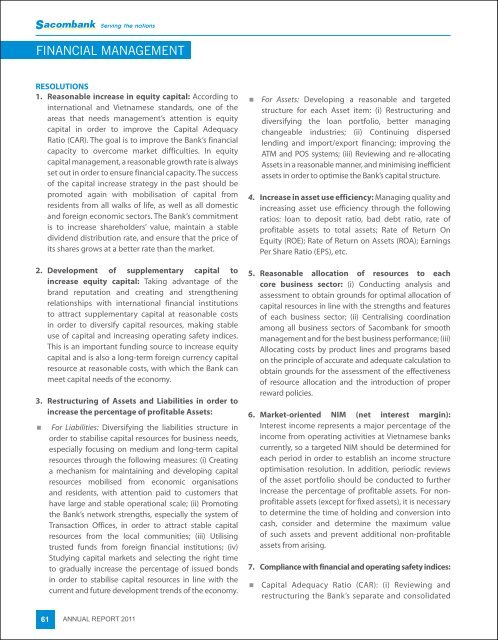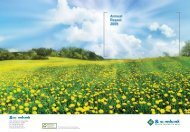notes to the consolidated financial statements - Sacombank
notes to the consolidated financial statements - Sacombank
notes to the consolidated financial statements - Sacombank
Create successful ePaper yourself
Turn your PDF publications into a flip-book with our unique Google optimized e-Paper software.
FInAnCIAL MAnAGEMEnt<br />
RESOLUTIONS<br />
1. Reasonable increase in equity capital: According <strong>to</strong><br />
international and Vietnamese standards, one of <strong>the</strong><br />
areas that needs management’s attention is equity<br />
capital in order <strong>to</strong> improve <strong>the</strong> Capital Adequacy<br />
Ratio (CAR). The goal is <strong>to</strong> improve <strong>the</strong> Bank’s <strong>financial</strong><br />
capacity <strong>to</strong> overcome market difficulties. In equity<br />
capital management, a reasonable growth rate is always<br />
set out in order <strong>to</strong> ensure <strong>financial</strong> capacity. The success<br />
of <strong>the</strong> capital increase strategy in <strong>the</strong> past should be<br />
promoted again with mobilisation of capital from<br />
residents from all walks of life, as well as all domestic<br />
and foreign economic sec<strong>to</strong>rs. The Bank’s commitment<br />
is <strong>to</strong> increase shareholders’ value, maintain a stable<br />
dividend distribution rate, and ensure that <strong>the</strong> price of<br />
its shares grows at a better rate than <strong>the</strong> market.<br />
2. Development of supplementary capital <strong>to</strong><br />
increase equity capital: Taking advantage of <strong>the</strong><br />
brand reputation and creating and streng<strong>the</strong>ning<br />
relationships with international <strong>financial</strong> institutions<br />
<strong>to</strong> attract supplementary capital at reasonable costs<br />
in order <strong>to</strong> diversify capital resources, making stable<br />
use of capital and increasing operating safety indices.<br />
This is an important funding source <strong>to</strong> increase equity<br />
capital and is also a long-term foreign currency capital<br />
resource at reasonable costs, with which <strong>the</strong> Bank can<br />
meet capital needs of <strong>the</strong> economy.<br />
3. Restructuring of Assets and Liabilities in order <strong>to</strong><br />
increase <strong>the</strong> percentage of profitable Assets:<br />
n For Liabilities: Diversifying <strong>the</strong> liabilities structure in<br />
order <strong>to</strong> stabilise capital resources for business needs,<br />
especially focusing on medium and long-term capital<br />
resources through <strong>the</strong> following measures: (i) Creating<br />
a mechanism for maintaining and developing capital<br />
resources mobilised from economic organisations<br />
and residents, with attention paid <strong>to</strong> cus<strong>to</strong>mers that<br />
have large and stable operational scale; (ii) Promoting<br />
<strong>the</strong> Bank’s network strengths, especially <strong>the</strong> system of<br />
Transaction Offices, in order <strong>to</strong> attract stable capital<br />
resources from <strong>the</strong> local communities; (iii) Utilising<br />
trusted funds from foreign <strong>financial</strong> institutions; (iv)<br />
Studying capital markets and selecting <strong>the</strong> right time<br />
<strong>to</strong> gradually increase <strong>the</strong> percentage of issued bonds<br />
in order <strong>to</strong> stabilise capital resources in line with <strong>the</strong><br />
current and future development trends of <strong>the</strong> economy.<br />
61<br />
ANNUAL REPORT 2011<br />
n For Assets: Developing a reasonable and targeted<br />
structure for each Asset item: (i) Restructuring and<br />
diversifying <strong>the</strong> loan portfolio, better managing<br />
changeable industries; (ii) Continuing dispersed<br />
lending and import/export financing; improving <strong>the</strong><br />
ATM and POS systems; (iii) Reviewing and re-allocating<br />
Assets in a reasonable manner, and minimising inefficient<br />
assets in order <strong>to</strong> optimise <strong>the</strong> Bank’s capital structure.<br />
4. Increase in asset use efficiency: Managing quality and<br />
increasing asset use efficiency through <strong>the</strong> following<br />
ratios: loan <strong>to</strong> deposit ratio, bad debt ratio, rate of<br />
profitable assets <strong>to</strong> <strong>to</strong>tal assets; Rate of Return On<br />
Equity (ROE); Rate of Return on Assets (ROA); Earnings<br />
Per Share Ratio (EPS), etc.<br />
5. Reasonable allocation of resources <strong>to</strong> each<br />
core business sec<strong>to</strong>r: (i) Conducting analysis and<br />
assessment <strong>to</strong> obtain grounds for optimal allocation of<br />
capital resources in line with <strong>the</strong> strengths and features<br />
of each business sec<strong>to</strong>r; (ii) Centralising coordination<br />
among all business sec<strong>to</strong>rs of <strong>Sacombank</strong> for smooth<br />
management and for <strong>the</strong> best business performance; (iii)<br />
Allocating costs by product lines and programs based<br />
on <strong>the</strong> principle of accurate and adequate calculation <strong>to</strong><br />
obtain grounds for <strong>the</strong> assessment of <strong>the</strong> effectiveness<br />
of resource allocation and <strong>the</strong> introduction of proper<br />
reward policies.<br />
6. Market-oriented NIM (net interest margin):<br />
Interest income represents a major percentage of <strong>the</strong><br />
income from operating activities at Vietnamese banks<br />
currently, so a targeted NIM should be determined for<br />
each period in order <strong>to</strong> establish an income structure<br />
optimisation resolution. In addition, periodic reviews<br />
of <strong>the</strong> asset portfolio should be conducted <strong>to</strong> fur<strong>the</strong>r<br />
increase <strong>the</strong> percentage of profitable assets. For nonprofitable<br />
assets (except for fixed assets), it is necessary<br />
<strong>to</strong> determine <strong>the</strong> time of holding and conversion in<strong>to</strong><br />
cash, consider and determine <strong>the</strong> maximum value<br />
of such assets and prevent additional non-profitable<br />
assets from arising.<br />
7. Compliance with <strong>financial</strong> and operating safety indices:<br />
n Capital Adequacy Ratio (CAR): (i) Reviewing and<br />
restructuring <strong>the</strong> Bank’s separate and <strong>consolidated</strong>




